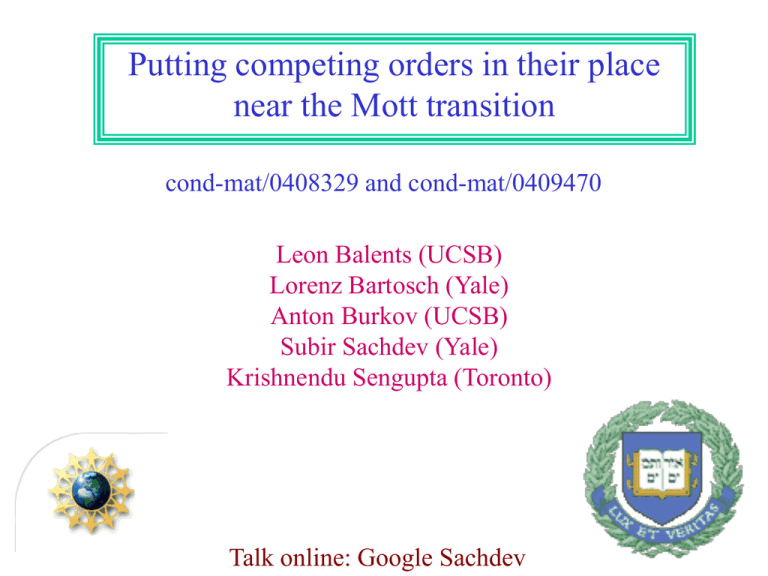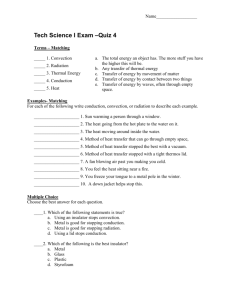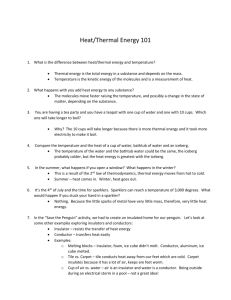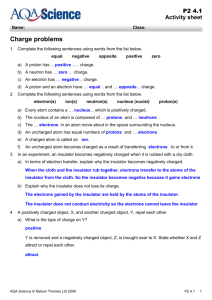PowerPoint
advertisement

Putting competing orders in their place near the Mott transition cond-mat/0408329 and cond-mat/0409470 Leon Balents (UCSB) Lorenz Bartosch (Yale) Anton Burkov (UCSB) Subir Sachdev (Yale) Krishnendu Sengupta (Toronto) Talk online: Google Sachdev Distinct experimental charcteristics of underdoped cuprates at T > Tc Measurements of Nernst effect are well explained by a model of a liquid of vortices and anti-vortices N. P. Ong, Y. Wang, S. Ono, Y. Ando, and S. Uchida, Annalen der Physik 13, 9 (2004). Y. Wang, S. Ono, Y. Onose, G. Gu, Y. Ando, Y. Tokura, S. Uchida, and N. P. Ong, Science 299, 86 (2003). Distinct experimental charcteristics of underdoped cuprates at T > Tc STM measurements observe “density” modulations with a period of ≈ 4 lattice spacings LDOS of Bi2Sr2CaCu2O8+d at 100 K. M. Vershinin, S. Misra, S. Ono, Y. Abe, Y. Ando, and A. Yazdani, Science, 303, 1995 (2004). Is there a connection between vorticity and “density” wave modulations? “Density” wave order---modulations in pairing amplitude, exchange energy, or hole density. Equivalent to valence-bond-solid (VBS) order (except at the special period of 2 lattice spacings) Vortex-induced LDOS of Bi2Sr2CaCu2O8+d integrated from 1meV to 12meV at 4K Vortices have halos with LDOS modulations at a period ≈ 4 lattice spacings 7 pA b 0 pA 100Å J. Hoffman E. W. Hudson, K. M. Lang, V. Madhavan, S. H. Pan, H. Eisaki, S. Uchida, and J. C. Davis, Science 295, 466 (2002). Prediction of VBS order near vortices: K. Park and S. Sachdev, Phys. Rev. B 64, 184510 (2001). Landau-Ginzburg-Wilson theory of multiple order parameters: • “Vortex/phase fluctuations” (“preformed pairs”) Complex superconducting order parameter: Ysc Y sc Y sc ei symmetry encodes number conservation • “Charge/valence-bond/pair-density/stripe” order Order parameters: r Q e iQ . r Q Q Q ei encodes space group symmetry Landau-Ginzburg-Wilson theory of multiple order parameters: LGW free energy: F Fsc Y sc Fcharge Q Fint Fsc Y sc r1 Y sc u1 Y sc 2 4 2 4 Fcharge Q r2 Q u2 Q Fint v Y sc 2 2 Q Distinct symmetries of order parameters permit couplings only between their energy densities (there are no symmetries which “rotate” two order parameters into each other) For large positive v, there is a correlation between vortices and density wave order Predictions of LGW theory Y sc Superconductor First order transition Q Charge-ordered insulator r1 r2 Predictions of LGW theory Y sc First order transition Superconductor Y sc Superconductor Q Charge-ordered insulator r1 r2 Coexistence (Supersolid) Q Charge-ordered insulator r1 r2 Predictions of LGW theory Y sc First order transition Superconductor Y sc Charge-ordered insulator r1 r2 Coexistence (Supersolid) Superconductor Y sc Superconductor Q Q Charge-ordered insulator r1 r2 " Disordered " ( topologically ordered) Y sc 0, Q 0 Q Charge-ordered insulator r r 1 2 Predictions of LGW theory Y sc First order transition Superconductor Y sc Charge-ordered insulator r1 r2 Coexistence (Supersolid) Superconductor Y sc Superconductor Q Q Charge-ordered insulator r1 r2 " Disordered " ( topologically ordered) Y sc 0, Q 0 Q Charge-ordered insulator r r 1 2 Non-superconducting quantum phase must have some other “order”: • Charge order in an insulator • Fermi surface in a metal • “Topological order” in a spin liquid • …………… This requirement is not captured by LGW theory. Needed: a theory of precursor fluctuations of the density wave order of the insulator within the superconductor. i.e. a connection between vortices and density wave order Outline A. Superfluid-insulator transitions of bosons on the square lattice at fractional filling Quantum mechanics of vortices in a superfluid proximate to a commensurate Mott insulator B. Application to a short-range pairing model for the cuprate superconductors Competition between VBS order and d-wave superconductivity A. Superfluid-insulator transitions of bosons on the square lattice at fractional filling Quantum mechanics of vortices in a superfluid proximate to a commensurate Mott insulator Bosons at density f 1 Weak interactions: superfluidity Strong interactions: Mott insulator which preserves all lattice symmetries LGW theory: continuous quantum transitions between these states M. Greiner, O. Mandel, T. Esslinger, T. W. Hänsch, and I. Bloch, Nature 415, 39 (2002). Bosons at density f 1/2 (equivalent to S=1/2 AFMs) Y sc 0 Weak interactions: superfluidity Strong interactions: Candidate insulating states 1 2 ( + ) All insulating phases have density-wave order r Q eiQ.r with Q 0 Q C. Lannert, M.P.A. Fisher, and T. Senthil, Phys. Rev. B 63, 134510 (2001) S. Sachdev and K. Park, Annals of Physics, 298, 58 (2002) Predictions of LGW theory Y sc First order transition Superconductor Y sc Charge-ordered insulator r1 r2 Coexistence (Supersolid) Superconductor Y sc Superconductor Q Q Charge-ordered insulator r1 r2 " Disordered " ( topologically ordered) Y sc 0, Q 0 Q Charge-ordered insulator r r 1 2 Predictions of LGW theory Y sc First order transition Superconductor Y sc Charge-ordered insulator r1 r2 Coexistence (Supersolid) Superconductor Y sc Superconductor Q Q Charge-ordered insulator r1 r2 " Disordered " ( topologically ordered) Y sc 0, Q 0 Q Charge-ordered insulator r r 1 2 Boson-vortex duality Quantum mechanics of twodimensional bosons: world lines of bosons in spacetime t y x C. Dasgupta and B.I. Halperin, Phys. Rev. Lett. 47, 1556 (1981); D.R. Nelson, Phys. Rev. Lett. 60, 1973 (1988); M.P.A. Fisher and D.-H. Lee, Phys. Rev. B 39, 2756 (1989); Boson-vortex duality Classical statistical mechanics of a “dual” threedimensional “superconductor”, with order parameter j : z trajectories of vortices in a y “magnetic” field x Strength of “magnetic” field on dual superconductor j = density of bosons = f flux quanta per plaquette C. Dasgupta and B.I. Halperin, Phys. Rev. Lett. 47, 1556 (1981); D.R. Nelson, Phys. Rev. Lett. 60, 1973 (1988); M.P.A. Fisher and D.-H. Lee, Phys. Rev. B 39, 2756 (1989); Boson-vortex duality Current of j boson e vortex i 2 The wavefunction of a vortex acquires a phase of 2 each time the vortex encircles a boson Strength of “magnetic” field on dual superconductor j = density of bosons = f flux quanta per plaquette C. Dasgupta and B.I. Halperin, Phys. Rev. Lett. 47, 1556 (1981); D.R. Nelson, Phys. Rev. Lett. 60, 1973 (1988); M.P.A. Fisher and D.-H. Lee, Phys. Rev. B 39, 2756 (1989); Boson-vortex duality Statistical mechanics of dual “superconductor” j, is invariant under the square lattice space group: Tx , Ty : Translations by a lattice spacing in the x, y directions R : Rotation by 90 degrees. Magnetic space group: TxTy e 2 if TyTx ; 1 1 R Ty R Tx ; R Tx R T 1 y ; R 1 4 Strength of “magnetic” field on dual superconductor j = density of bosons = f flux quanta per plaquette Boson-vortex duality Hofstadter spectrum of dual “superconducting” order j At density f =p / q (p, q relatively prime integers) there are q species of vortices, j (with =1 q), associated with q gauge-equivalent regions of the Brillouin zone Magnetic space group: TxTy e 2 if TyTx ; 1 1 R Ty R Tx ; R Tx R T 1 y ; R 1 4 Boson-vortex duality Hofstadter spectrum of dual “superconducting” order j At density f =p / q (p, q relatively prime integers) there are q species of vortices, j (with =1 q), associated with q gauge-equivalent regions of the Brillouin zone The q vortices form a projective representation of the space group Tx : j j 1 ; Ty : j e2 i f j 1 q 2 i mf R :j j e m q m1 See also X.-G. Wen, Phys. Rev. B 65, 165113 (2002) Boson-vortex duality The q j vortices characterize both superconducting and density wave orders Superconductor insulator : j 0 j 0 Boson-vortex duality The q j vortices characterize both superconducting and density wave orders Density wave order: Status of space group symmetry determined by 2 p density operators Q at wavevectors Qmn m, n q mn e i mnf Tx : Q Q eiQ q * 2 i mf j j e n 1 xˆ ; Ty : Q Q eiQ yˆ R : Q RQ Each pinned vortex in the superfluid has a halo of density wave order over a length scale ≈ the zero-point quantum motion of the vortex. This scale diverges upon approaching the Mott insulator Vortex-induced LDOS of Bi2Sr2CaCu2O8+d integrated from 1meV to 12meV at 4K Vortices have halos with LDOS modulations at a period ≈ 4 lattice spacings 7 pA b 0 pA 100Å J. Hoffman E. W. Hudson, K. M. Lang, V. Madhavan, S. H. Pan, H. Eisaki, S. Uchida, and J. C. Davis, Science 295, 466 (2002). Prediction of VBS order near vortices: K. Park and S. Sachdev, Phys. Rev. B 64, 184510 (2001). Predictions of LGW theory Y sc First order transition Superconductor Y sc Charge-ordered insulator r1 r2 Coexistence (Supersolid) Superconductor Y sc Superconductor Q Q Charge-ordered insulator r1 r2 " Disordered " ( topologically ordered) Y sc 0, Q 0 Q Charge-ordered insulator r r 1 2 Analysis of “extended LGW” theory of projective representation Fluctuation-induced, Y sc weak, first order transition Superconductor j 0, mn 0 Q Charge-ordered insulator j 0, mn 0 r1 r2 Analysis of “extended LGW” theory of projective representation Fluctuation-induced, Y sc weak, first order transition Q Superconductor Charge-ordered insulator j 0, mn 0 Y sc Superconductor j 0, mn 0 j 0, mn 0 r1 r2 Supersolid Q j 0, mn 0 Charge-ordered insulator j 0, mn 0 r1 r2 Analysis of “extended LGW” theory of projective representation Fluctuation-induced, Y sc weak, first order transition Q Superconductor Charge-ordered insulator j 0, mn 0 Y sc Superconductor j 0, mn 0 Y sc Superconductor j 0, mn 0 j 0, mn 0 r1 r2 Supersolid Q j 0, mn 0 Charge-ordered insulator j 0, mn 0 r1 r2 Second order transition Q Charge-ordered insulator j 0, mn 0 r1 r2 Analysis of “extended LGW” theory of projective representation Spatial structure of insulators for q=4 (f=1/4 or 3/4) a b unit cells; q , q , ab , a b q all integers B. Application to a short-range pairing model for the cuprate superconductors Competition between VBS order and d-wave superconductivity Phase diagram of doped antiferromagnets g = parameter controlling strength of quantum fluctuations in a semiclassical theory of the destruction of Neel order La2CuO4 Neel order Phase diagram of doped antiferromagnets g or VBS order La2CuO4 Neel order N. Read and S. Sachdev, Phys. Rev. Lett. 62, 1694 (1989). T. Senthil, A. Vishwanath, L. Balents, S. Sachdev and M.P.A. Fisher, Science 303, 1490 (2004). Phase diagram of doped antiferromagnets g or Dual vortex theory for interplay between VBS order and d-wave superconductivity VBS order La2CuO4 Neel order Hole density d A convenient derivation of the dual theory for vortices is obtained from the doped quantum dimer model H dqd J t Density of holes = d E. Fradkin and S. A. Kivelson, Mod. Phys. Lett. B 4, 225 (1990). Duality mapping of doped dimer model shows: Vortices in the superconducting state obey the magnetic translation algebra TxTy e 2 if TyTx p 1 d MI with f q 2 where d MI is the density of holes in the proximate Mott insulator (for d MI 1/ 8, f 7 /16 q 16) Most results of Part A on bosons can be applied unchanged with q as determined above Phase diagram of doped antiferromagnets g VBS order d 132 La2CuO4 Neel order Hole density d Phase diagram of doped antiferromagnets g VBS order d 116 La2CuO4 Neel order Hole density d Phase diagram of doped antiferromagnets g VBS order d 18 La2CuO4 Neel order Hole density d Phase diagram of doped antiferromagnets g d-wave superconductivity above a critical d VBS order La2CuO4 Neel order Hole density d Conclusions I. Description of the competition between superconductivity and density wave order in term of defects (vortices). Theory naturally excludes “disordered” phase with no order. II. Vortices carry the quantum numbers of both superconductivity and the square lattice space group (in a projective representation). III. Vortices carry halo of charge order, and pinning of vortices/anti-vortices leads to a unified theory of STM modulations in zero and finite magnetic fields. IV. Conventional (LGW) picture: density wave order causes the transport energy gap, the appearance of the Mott insulator. Present picture: Mott localization of charge carriers is more fundamental, and (weak) density wave order emerges naturally in theory of the Mott transition.


